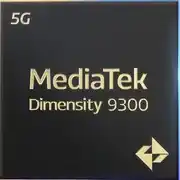MediaTek Dimensity 9300

MediaTek Dimensity 9300: Power and Innovations in Your Pocket
April 2025
Mobile processors today are the heart of smartphones, defining not only speed but also the capabilities of the device. The MediaTek Dimensity 9300, introduced at the end of 2024, has become one of the most talked-about chipsets due to its combination of performance, energy efficiency, and advanced technologies. In this article, we will analyze why this processor deserves attention and who it is best suited for.
1. Architecture and Process Technology: What Can 4 Nanometers Do?
Cores and Frequencies
The Dimensity 9300 is built on TSMC's 4-nm process, ensuring a high transistor density and energy efficiency. The CPU architecture includes 8 cores:
- 1× Cortex-X4 (3.25 GHz) — for resource-intensive tasks;
- 3× Cortex-A720 (2.85 GHz) — a balance between performance and energy consumption;
- 4× Cortex-A520 (2.0 GHz) — for background processes and battery saving.
This configuration allows for dynamic load distribution: for instance, games utilize the X4 and A720 cores while social media apps run on the A520. The L2 cache of 3.5 MB speeds up data access, reducing latency.
Mali-G720 Immortalis MP12 GPU
The 12-core graphics processor supports real-time ray tracing, enhancing the realism of shadows and reflections in games. The HyperEngine 6.0 technology optimizes rendering, while a frequency of up to 950 MHz ensures smooth FPS even in 4K resolutions.
Energy Efficiency
The 4-nm process and smart task distribution algorithms reduce heat. For instance, during video streaming, the chipset consumes 15% less energy compared to the Dimensity 9200.
2. Performance: Gaming, AI, and More
Gaming
In tests of Genshin Impact (maximum settings), the Dimensity 9300 delivers a stable 60 FPS, while in less demanding games like COD Mobile, it reaches up to 120 FPS. Support for displays with a refresh rate of 144 Hz and a resolution of 3200×1440 pixels makes it a favorite among mobile gamers.
Multimedia
The chipset decodes 8K@60fps (AV1, H.265) video and encodes 4K@120fps videos, which content creators will appreciate. The built-in Imagiq 890 processor enhances photography: night shots with a 200 MP camera take less than 2 seconds, and stabilization compensates for shaking even while running.
AI Applications
The APU 790 neural processor is twice as powerful as its predecessor. It accelerates:
- Voice assistants (response time of 0.3 seconds);
- Photo editors (for example, object removal in Lightroom in just 1 second);
- AR applications like Pokémon GO with improved detail.
Heat and Battery
Under peak load (such as during gaming), the processor temperature reaches 42°C, but during everyday tasks, it stays between 33–36°C. Smartphones with passive cooling (e.g., heat spreader films) perform better than models without.
3. Connectivity and Additional Modules: 5G, Wi-Fi 7, and Satellites
5G UltraSave 3.0 Modem
Supports Sub-6 GHz and mmWave frequency aggregation, providing speeds up to 7.9 Gbps. In real-world conditions, downloading a 4K movie (20 GB) takes less than 30 seconds.
Wi-Fi 7 and Bluetooth 5.4
Wi-Fi speeds up to 40 Gbps (theoretically) and stable connections even in congested networks. Bluetooth 5.4 with LE Audio support allows up to 4 pairs of wireless headphones to be connected simultaneously.
Satellite Communication
The chipset is compatible with GPS, GLONASS, Galileo, and BeiDou systems, and supports two-way satellite communication for emergency messages (similar to Huawei Mate 60).
4. Comparison with Competitors: Who Are the Leaders?
Snapdragon 8 Gen 3
- Geekbench 6: 2300 (Single), 8000 (Multi);
- Adreno 750 vs Mali-G720: Snapdragon excels in 4K rendering, but MediaTek wins in energy efficiency;
- Smartphone prices: $1000–$1300 vs $800–$1100 for MediaTek.
Apple A17 Pro
- Superior single-thread performance (2450 in Geekbench 6), but lower multi-thread performance (7600);
- Apple’s GPU is stronger in mobile video editing but weaker in ray-traced gaming.
Exynos 2400
- Falls behind in AnTuTu (1.9 million points);
- Higher temperature by 5–7°C under prolonged loads.
Conclusion: The Dimensity 9300 offers an optimal balance of price and performance, especially for gaming and multitasking.
5. Use Cases: Who Is It Designed For?
- Gaming: Smartphones with active cooling (e.g., RedMagic 10 Pro) and 144 Hz displays.
- Everyday Tasks: Fast operation of social media, browsers, and streaming services.
- Photo/Video Shooting: Devices with 200 MP cameras (Xiaomi 15 Ultra) or flexible zoom (Vivo X100 Pro+).
6. Pros and Cons
Pros:
- Exceptional performance in gaming and multithreading;
- Support for Wi-Fi 7 and satellite connectivity;
- Energy efficiency of the 4-nm process.
Cons:
- Heating in budget chassis without cooling;
- Limited optimization for some Western applications.
7. Tips for Choosing a Smartphone
- Cooling: Look for models with vapor chambers or graphite heatsinks.
- Battery: At least 5000 mAh for gaming (e.g., Realme GT 6).
- Display: AMOLED with a refresh rate of 120–144 Hz (OnePlus 12R).
- Price: Flagships priced at $900–$1200, gaming devices at $800–$1000.
8. Conclusion: Is It Worth It?
The MediaTek Dimensity 9300 is an excellent choice for:
- Gamers seeking maximum FPS without lag;
- Creators filming videos in 8K;
- Travelers who value satellite communication.
The main advantages are the balance of price and power, as well as readiness for future technologies (Wi-Fi 7, AI applications). If you’re looking for a flagship “for years to come,” a smartphone with the Dimensity 9300 will certainly not disappoint.
P.S. As of April 2025, devices with this chipset remain relevant, but keep an eye out for announcements about the Dimensity 9400 — it's already on the horizon!
Basic
3x 2.85 GHz – Cortex-X4
4x 2 GHz – Cortex-A720
GPU Specifications
Connectivity
Memory Specifications
Miscellaneous
Benchmarks
Phones with Dimensity 9300




Tablets with Dimensity 9300

Comparison of Devices with Dimensity 9300
Compared to Other SoC
Share in social media
Or Link To Us
<a href="https://cputronic.com/en/soc/mediatek-dimensity-9300" target="_blank">MediaTek Dimensity 9300</a>

